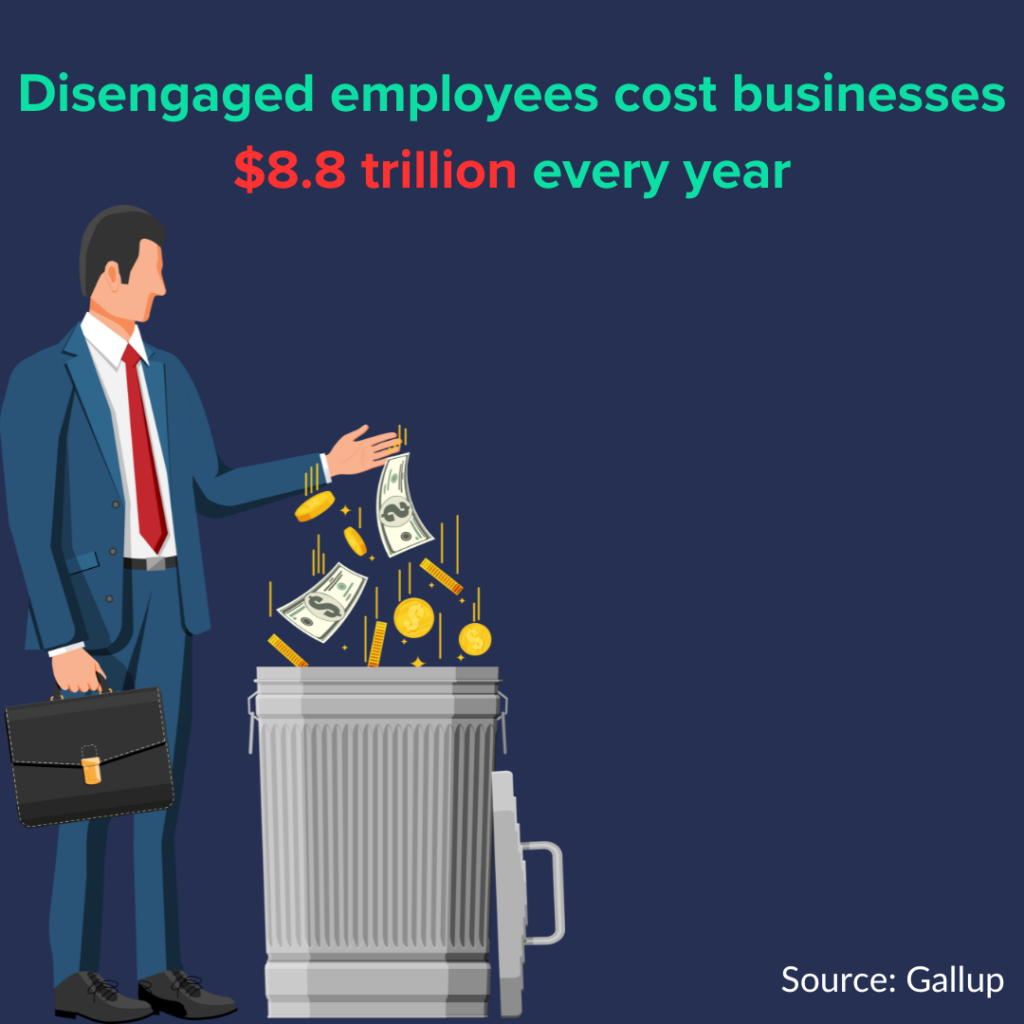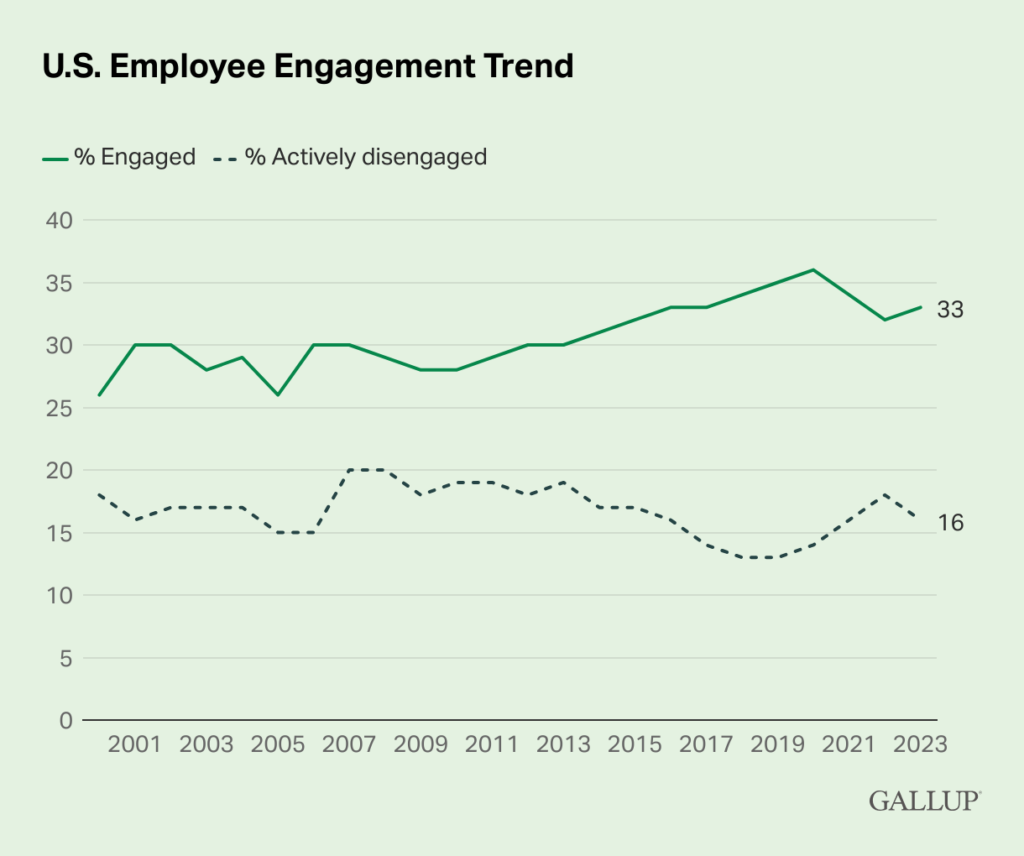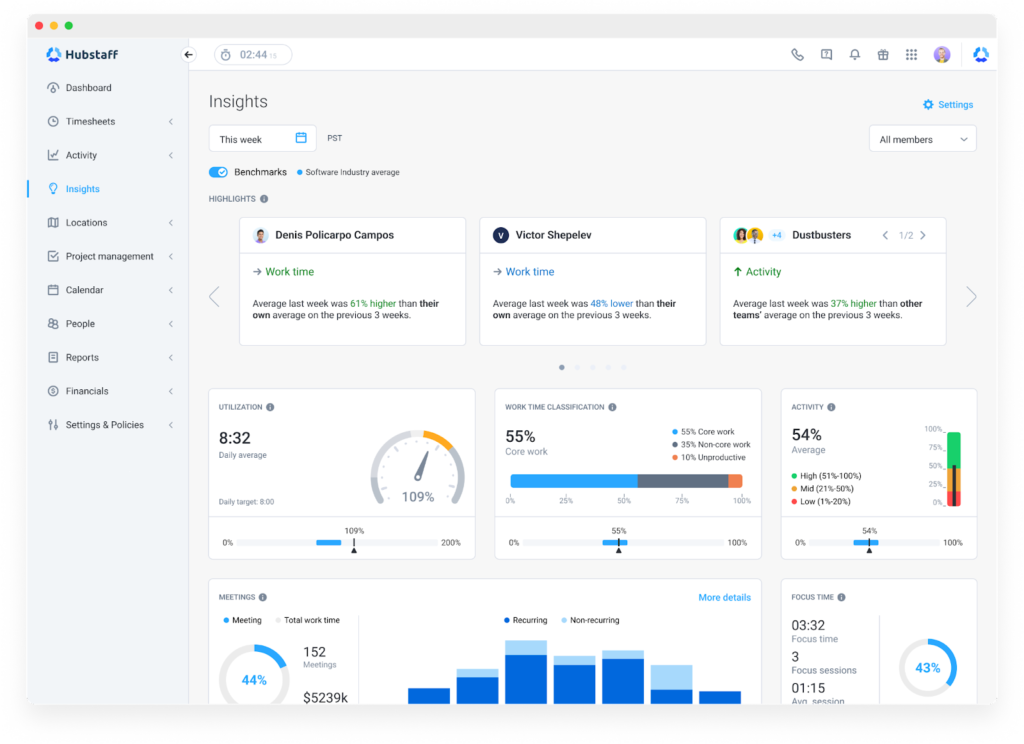Employee disengagement is a silent epidemic affecting companies worldwide, harming much more than productivity. It’s easy to view the cost of disengaged employees as something only the company pays from its bottom line, but the threat is much more intrinsic.
When your employees are disengaged, everything is at risk — from profits and products to careers and even your happiest team members.
Their disconnection has a noticeable ripple effect, often noticed first in reduced productivity, lower morale, and higher turnover rates. But warning signs tend to appear before these dire results. So, in this comprehensive guide, we’ll delve into the cost of disengaged employees and share strategies to reignite your team’s passion and drive. I hope to help teams like yours spot these challenges before they become a retention issue.
Boost your team’s efficiency with Hubstaff's productivity tools
A quick disengagement definition
Employee disengagement is a phenomenon where employees become emotionally disconnected from their jobs and companies at large. They withdraw from work and colleagues, put in less effort, and have a reduced sense of enjoyment and meaning from work.
Disengaged team members are less satisfied with their jobs, tasks, company, and team. They’re experiencing a loss of connection with your company’s mission, values, and purpose.
In more dire situations, disengaged employees say they’re less likely to feel like anyone at work cares about them as a person.

Disengagement by the numbers
Disengaged employees cost the world 9% of its total global GDP, or $8.8 trillion per year, according to Gallup’s State of the Global Workplace report.
That cost may seem high, but the company estimates that just 23% of people are engaged at work, while 18% are actively disengaged. The middle 59% of people aren’t disengaged but just put in the minimum work to get by. Gallup uses the term “quiet quitting,” but as we’ve not seen a substantial turnover of these employees since that term was adopted, it does not seem like the most accurate depiction.

The Gallup study dives a little deeper into regions and some countries in that report. It notes that in the US and parts of Europe, employee engagement is on the decline. South Asia, which includes India in this report, has some of the largest worker populations and is rising rapidly in terms of engaged employees.
If we look at the US in 2023, employee satisfaction and commitment are staying below pre-pandemic highs. Engagement sat at 33% for the year, slightly up from 32% in 2022 but down from the peak of 40% in 2020.
“Each percentage point gain or drop in engagement represents approximately 1.6 million full- or part-time employees in the US” — Gallup, State of the Global Workplace

Why employee engagement matters
The numbers above don’t lie — disengagement hurts your bottom line.
However, there’s a risk in leaving disengagement unchecked and unaddressed. You can’t just fire the disengaged team members because that fails to get at the root of why someone goes from engaged to disengaged. You can’t let this illness thrive.
Engaged employees offer you a few core benefits that are worth protecting:
- Organizations with high employee engagement are 21% more profitable
- For revenue, companies with a positive company culture generate a 4X higher revenue
- Engaged employees are generally more productive with their output and efficient with their time
- Highly engaged workforces have an 81% lower absenteeism rate
- An engaged employee who receives regular feedback takes more initiative
- Co-workers view engaged colleagues as better collaborators
- Workplaces with high engagement experience 18% less turnover
Quantifying the cost of disengaged employees
A disengaged staff will cost you, and it could be quite a lot.
Gallup has data suggesting that each actively disengaged employee costs their company roughly 18% of that employee’s annual salary. That’s a little on the lower end of things, as some estimates go as high as 33% of their annual salary.
If you’re in the US, that means about $10,000 based on the average salary. Even at minimum wage, that cost will hit a business for $1,508 per person. When companies try to estimate how much a less productive staff member costs compared to having a high performer in that role, disengaged employees can cost you another $4,000 to $10,000.
Those are more direct, significant costs you can track based on performance, output, and meeting goals. To understand the total threat to an organization, we also should consider indirect costs and cultural risks associated with disengagement.
Thoughts on the indirect costs of disengagement
The direct costs, ones you can put a figure on, include absenteeism, paying for new employees or replacements, overtime when someone doesn’t show up for a shift, separation agreements, or even payouts for things like PTO when the person leaves.
Customer complaints often increase when engaged business units start to struggle. Losing support from engaged teams harms what customers get from you. This means the actual cost of disengagement could be much higher as sales and repeat business decline.
Your overall decreased productivity also impacts how much more money you can make in the future.
Unfortunately, indirect costs are more challenging to measure and are potentially more substantial. These encompass errors due to lack of focus, lost opportunities, and the domino effect on team dynamics. Other members can make mistakes due to stress and burnout.
If a shift or team becomes disengaged, you’ll spend a lot on recovery planning. Those threats and HR costs together lower both baseline revenue and potential profitability.
When disengagement strikes, the ripple can spread under the radar until it’s a tumultuous wave. You can miss the issue by not tracking indirect risks until you’ve already paid higher operational costs and seen client relationships suffer.

Research, examples, and case studies
Disengaged employees are a continual threat to businesses and teams. They’re also often a symptom of issues at an organization. Here is some research you may want to check out to learn more about the risk of disengagement and what company decisions lead to these issues:
- Recurring mass layoffs leave employees increasingly worried and disengaged
- Employees worry that a company relying on AI will harm salaries and reduce their chance for promotions, creating disengagement
- Actively disengaged employees take twice as many sick days as others
- The true cost to replace a disengaged employee can be as much as three to four times that role’s annual salary
- Forcing employees back to the office can lead to higher disengagement and reduced performance
- More than 50% of US workers feel under-compensated, a core driver of disengagement
- 70% of people wish their management spent more time with them, and 75% say they need feedback more often
Key factors contributing to employee disengagement
Before you can tackle disengagement, it’s paramount to pinpoint its roots.
Common factors include a lack of career development, poor leadership, and insufficient employee recognition. Addressing these underlying issues is the first step towards an actively engaged workforce.
Here are some issues that might be impacting your workforce:
Key issues that might impact your workforce:
- Disconnect with meaning: Most people want to do meaningful work. Defining meaning can be anything from company goals to being able to provide for their individual life and family. People stop caring about their performance when work doesn’t connect to that culture or meaning.
- Lack of control: People need some ability to drive what they do or how they work. People can grow frustrated and resentful when they don’t have control or autonomy.
- Lack of resources: Businesses need to provide backing to team members. Actively disengaged employees often feel asked to do too much without enough support. Resources can include budget, tools, and support from team members and managers.
- Lack of opportunity: Related to a lack of resources, you’ll see employees tune out when they don’t have anywhere to go. We’ve never seen the phrase “dead-end job” used in a positive light, and we doubt you have either.
- Lack of recognition: Employees burn out faster when they don’t feel rewarded or recognized. Without this, team members struggle to know if their work means anything to anyone else. And don’t forget that providing recognition is one of the best ways for managers to learn about employee strengths and weaknesses.
- Boredom: Work needs to be exciting, challenging, complex, creative, or enjoyable. Otherwise, people get bored or make mistakes. Repetitive and monotonous work that lacks other motivating factors can be a significant cause of turnover.
- Burnout: Small things add up, and any reason above can stress your team. When it and other factors wear a team member down, they’ll burn out. At that stage, an actively disengaged team member will work less, be sick more often, and reduce the effectiveness of others.

Measuring employee disengagement
Without quantifiable data, it’s impossible to forge meaningful interventions. Let’s look at the tools and techniques to take a pulse on your organization’s engagement levels. With some, you can understand the sentiment beneath the surface and determine reasons for burnout, stress, and disengagement.
Tools and metrics for assessing employee engagement
Numerous frameworks and technological solutions are available to gauge engagement levels. The likes of annual employee engagement surveys, frequent pulse surveys, and comprehensive software analytics can peel back the layers of morale and identify concerning trends.
Here are some core options to consider:
- Employee surveys that let people share stress levels and frustrations
- Short weekly check-in meetings to discuss roadblocks, feedback, and praise
- HR platforms that collect reviews and allow you to look at feedback trends
- Social media and review sites like Glassdoor, where employees rate companies
- Onboarding, promotion, and exit interviews
- Employee-driven recognition tools to see which teams engage in positive ways
- Hubstaff analytics and similar options that watch patterns of work for potential issues
There’s no mix or single option that works for every organization. Read about your industry, team size, company size, location, and other factors to see what may fit your needs.
Researching what doesn’t work for your organization is just as important. For example, one standard recommendation is to ask people if they would recommend working for your company to friends or colleagues. This question is helpful when your company has resources to hire.
But what if people don’t feel your company will hire without needing to fire someone? Or if they think the hiring would limit things like bonuses? Here, scores are artificially lowered because of a threat to resources, not because of how they feel about work.

4 questions to help spot disengagement:
Disengaged employees can often be identified through behaviors that signal their detachment from the workplace. Company leaders should be vigilant to spot these warning signs.
To help, here are four questions recommended by experts to get leaders thinking about disengagement detection:
- Is there a recent change in the employee’s work quality or turnaround time?
- Has there been an increase in the number of sick days or late arrivals?
- Is the employee reluctant to contribute to meetings or to take on new tasks?
- Are there signs of negativity or withdrawal from colleagues and team activities?
Ready to step up? Check out our guide on how to drive employee engagement and regain some lost productivity while tackling employee turnover and company culture issues.
Utilizing workforce analytics to understand impact
Quantitative and qualitative data are your beacons in the disengagement storm. Tapping into analytics dashboards and survey results can illuminate the gravitas of disengagement, guiding you to make informed decisions and targeted improvements.

Hubstaff’s workforce analytics can make taking your company’s pulse easy based on various work and activity metrics. The sophisticated dashboard helps leaders pinpoint the factors contributing to burnout and disengagement, such as overtime trends, activity levels, and task completion times.
We take the guesswork out of the equation, transforming subjective gut feelings into objective, data-driven intelligence. This ability to harness sophisticated data analytics equips leaders not just to react to problems but to anticipate and mitigate them before they take root, ensuring operational resilience and employee well-being are maintained.
Customizable alerts and reports allow you to notice irregular behavior patterns, such as consistent overwork or decreased activity, often preceding burnout. By enabling team leads to act on this information, Hubstaff serves as a vigilant guardian, safeguarding your teams against the spiral into disengagement.
Let us give you the key to combat the hidden adversary of workplace disengagement, transforming diligent stewardship into a competitive advantage.
Conclusion
The statistics are clear — the cost of each actively disengaged employee is more than a line item on a budget; it’s a sinking anchor on the ship of productivity. To stay buoyant and competitive with top talent, it is vital to address disengagement head-on.
Leveraging the insights from this guide and employing tools like Hubstaff can be your strategic arsenal in mitigating the impact of disengagement. It’s time to turn your focus to the costs you can’t afford to ignore.
Your workforce is listening. The question is, are you?
Most popular
The Fundamentals of Employee Goal Setting
Employee goal setting is crucial for reaching broader business goals, but a lot of us struggle to know where to start. American...
Data-Driven Productivity with Hubstaff Insights: Webinar Recap
In our recent webinar, the product team provided a deep overview of the Hubstaff Insights add-on, a powerful productivity measurem...
The Critical Role of Employee Monitoring and Workplace Security
Why do we need employee monitoring and workplace security? Companies had to adapt fast when the world shifted to remote work...
15 Ways to Use AI in the Workforce
Whether through AI-powered project management, strategic planning, or simply automating simple admin work, we’ve seen a dramatic...




